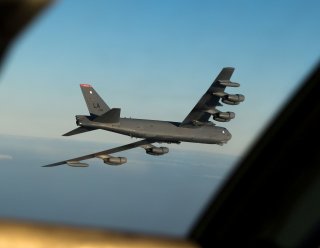The U.S. Navy Has New Plans for Sea Mines (Dropped from a B-52?)
The U.S. Navy issued a Request For Information (RFI) last month to determine which government contractors might be capable of designing, manufacturing and testing maritime mines that could be deployed at long ranges from the air. While the Navy may not even move forward with such a project, it suggests that there is interest from military planners to determine if the technologies could be developed to produce an sea mine from long ranges via the air.
The U.S. Navy issued a Request For Information (RFI) last month to determine which government contractors might be capable of designing, manufacturing and testing maritime mines that could be deployed at long ranges from the air. While the Navy may not even move forward with such a project, it suggests that there is interest from military planners to determine if the technologies could be developed to produce an sea mine from long ranges via the air.
The notice was issued by the Department of the Navy, Naval Sea Systems Command (NAVSEA), on behalf of the Program Executive Office (PEO) Undermanned and Small Combatants (USC), Mine Warfare Program Office (PMS 495).
“The objective of this notice is to help the Government determine the current technology available as well as capability and qualifications of companies in meeting the Government’s need to modernize the long-range air delivery of maritime mines,” the RFP stated, which was posted on GovTribe.com. “The mine may be required to deliver a minimum 500 lb explosive payload a minimum of 100 nautical miles with 2000 lb explosive payload and ranges beyond 100 nautical miles desired. Additionally, proposed design concepts may utilize the current target detecting, safety, and arming devices that are part of the current Quickstrike family of mines.”
Respondents to the RFP are requested to submit a white paper that includes capability statements and the key technical approaches used. This includes potential solutions and data such as range estimation, accuracy, warhead size and general mine size. The white papers should also include current Technology Readiness Levels (TRLs), maturity of potential solutions and development timelines.
“Combatant commanders require the capability to accurately emplace maritime mines into contested environments,” said the Navy as reported by FlightGlobal. “Current mining capability includes legacy, air-delivered, Quickstrike-series mines. Mine-laying aircraft must fly directly over each planned minefield at low altitude and speed to deliver mines, leaving the aircraft vulnerable to adversary anti-aircraft weapons.”
Air-dropped mines are not exactly a new concept either—and the U.S. military air-dropped mines in Japanese waters in 1945, which sank more ships in the final months of the Second World War than submarines. But the Quickstrike naval mine took aerial delivery a step further. In September 2014 one was dropped from a high-altitude B-52H bomber and it glided some forty nautical miles before entering the water, thanks to the inclusion of wings on the mine’s body.
The Navy has further outfitted Quickstrike mines with the tail assembly from a JDAM-ER (Joint Direct Attack Munition—Extended Range), and a pop-out wing kit. Though unpowered, the gliding mine can fly quite a long distance, which increases with the height at which it is dropped.
Mines remain an important part of the Navy’s arsenal as they serve a dual role as offensive/defense asymmetric weapon and for good reason have been described as “weapons that wait.” Since the end of World War II, it has been mines that have seriously damaged or sunk almost four times more Navy ships than all other means of attack combined.
The U.S. Navy has seen too that Beijing has upped its game when it comes to seeing the value in sea mines, with China turning to the successful use of mines by Russia throughout the twentieth-century even when Moscow wasn’t noted for having a significant blue water navy.
While the U.S. Navy’s Quickstrike-JDAM naval mine is easy to assemble, and can be deployed from high-flying aircraft, the Mine Warfare Program Office clearly is seeking something that could strike from more than double the current distances.
Peter Suciu is a Michigan-based writer who has contributed to more than four dozen magazines, newspapers and websites. He is the author of several books on military headgear including A Gallery of Military Headdress, which is available on Amazon.com.
Image: Reuters

